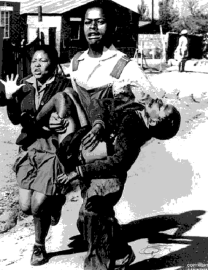NELSON MANDELA
18 July 1918 – 5 December 2013
One of the world’s biggest freedom fighters, South Africa’s first black chief executive and first black lawyer: ” Mandela ”
His history began with his struggle for freedom. He spent his young life fighting for the freedom of South Africa’s black population from oppression imposed by the minority government. He was imprisoned for 27 years. Soon after release, he became the first president of South Africa in elections and he gave great priority to reconciliation between the races. Today, he continues to be a source of inspiration for civil rights activists worldwide…
Apartheid Era
Apartheid era is the name which given to the period between the years 1948-1994 in the Republic of South Africa. In this period, people were divided into three groups by government: Whites, Hybrids and Blacks.
Pre-Apartheid Era
After African natives, people who came first to South Africa are from Dutch (Boer) . After the Dutch, the Britons came in 1795 and they occupied their territory . The Boer War happened between the British and Boer in 1899-1902 and British who are winner, captured gold deposits and established dominance in South Africa. After the war, while the British have all privileges thanks to their new constitution, black people have begun been exploited by a racist policy. Thereupon, blacks founded the African National Congress (ANC) and asked for the return of the rights they used to have, but their request was rejected by the government. The vote right was taken away from the black. National Party’s racist policies was not limited with it .Discrimination were in schools,public toilets, bus stations. “for whites only” signs were hung. Marriage between white and non-white was forbidden.
During Apartheid Era
National Party came to power in 1948 and apartheid era began officially. In 1952, Nelson Mandela became the ANC leader. Government wanted to Mandela to cut his relationship with the ANC but Mandela didn’t do it and he supported violence-free protests. Also he met with friends and secretly made a decision to initiate a strike. They prepared a underground sabotage program, which they called Umkhonto we Sizwe (Spear of the Nation) and period was beginning to put violence against violence. Mandela was arrested in 1962 and he was sentenced to 5 years. In 1963, police discovered the location of Umkhonto we Sizwe, Mandela was sentenced to life imprisonment and the ANC was closed.
In these years, the apartheid era was continuing. Especially, pressure increased on the black children in schools and it caused “Children’s Rebellion” . Police was suppressed rebellion in a bloody way, hundreds of children were killed. All the world’s eyes were turned to South Africa. Despite the government’s ban ,some images was leaked to the world press . Other countries began to impose sanctions and the economy was shaken. Thereupon in 1990, F.W.Klerk declared to make changes and he was elected as the new President of South Africa. Then, Klerk released Mandela on 11 February 1990, the ANC re-opened and negotiations between the ANC and the government has started.
Since 1990 Till Now
The new President of South Africa, Klerk lifted the apartheid laws. Blacks and Whites were equal then now. Right of vote were given back to the Black. In the elections of 1994, Nelson Mandela became the president of South Africa. Thanks to the constitution which entered into force in 1997, race, language and religion were no matter, all people considered to be equal. Infrastructure works started in the country, schools were opened, electricity and water were given to places where black people live. Trade promotion programs were prepared. Rapid development began in the country and today, South Africa is one of the richest countries in the world interms of gold and diamond…

F. W. de Klerk outside his office after the referendum to end apartheid, March 1992.
What about Gini in South Africa ?
As can be seen in the table to the left (taken from Race, Class, and Inequality in South Africa), the Gini coefficient for the white population in 1975 stood at a relatively low .36, signifying the success of the apartheid government in bolstering the position of the poorer members of the white community. An essential component of this program was the reservation of well-paying jobs for the white population. Furthermore, when taking into account welfare expenditures and educational opportunities, the white population actually had greater equality than the Gini index shows.
Of course, this leveling of the economic differences within the white population was dependent on the widening gap between white South Africans and everyone else, especially the black Africans. Because the apartheid government restricted the professions that blacks could choose, blacks were basically limited to lower-level jobs. In fact, this upper limit also facilitated an increase in equality within the black population, as even the well-educated blacks could not find well-paying jobs.
Helin Azizoglu
11324054
Sources:
http://www.geocurrents.info/economic-geography/inequality-trends-in-south-africa








